Menu
Elton Was the Bally Table King in 1976
Let us run down a checklist that Elton fans might use in going through or adding to their collection.
Vinyl releases and CDs? Check.
Concert ticket stubs? Check.
Posters and memorabilia? Check.
Pinball Machine? Che–wait…what?
By John F. Higgins
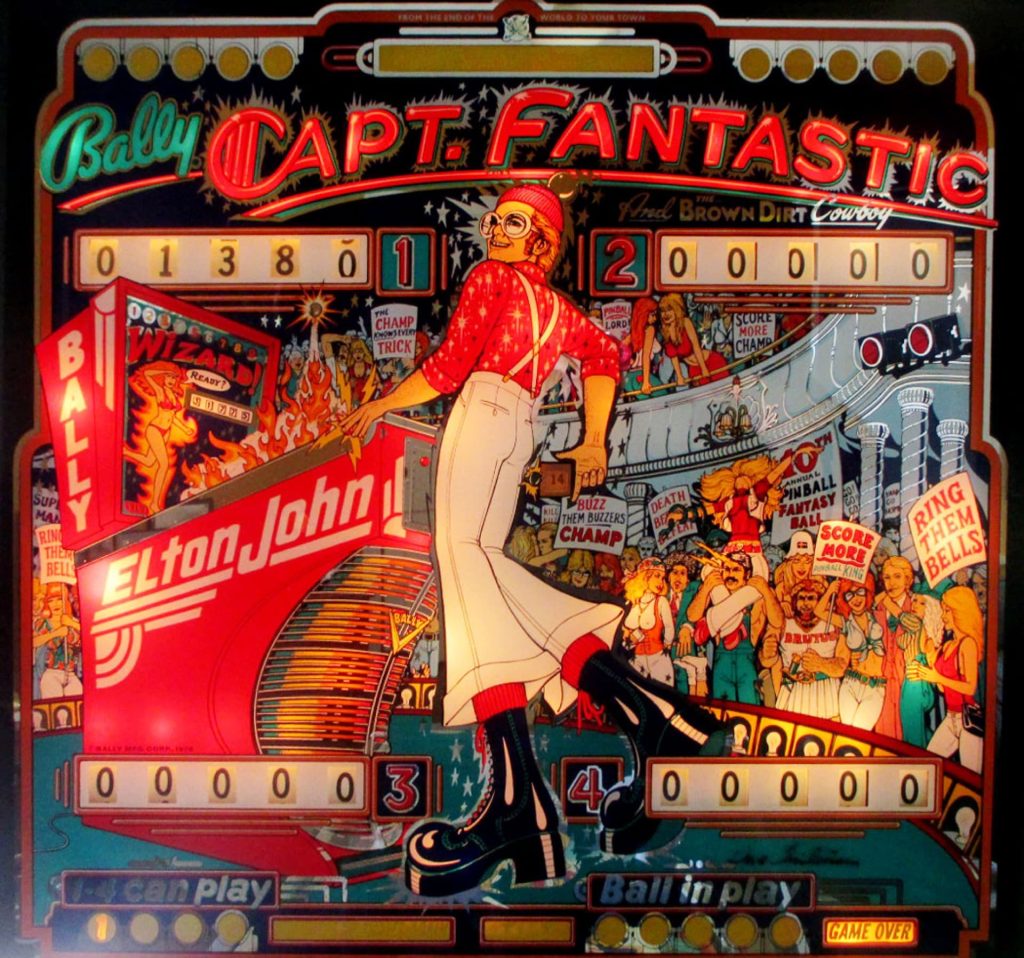
In June of 1976, as the music public took a brief breather in between Rock Of The Westies and Blue Moves, and as Don’t Go Breaking My Heart was waiting for the needle to drop, Bally Manufacturing Corporation released their model 1062…also known as the Captain Fantastic And The Brown Dirt Cowboy pinball machine.
The idea was the brainstorm of Tom Nieman, now Vice President of Marketing for JCM Global and then a just-out-of-college employee at Bally’s global headquarters in Chicago.
In an exclusive interview with EltonJohn.com, Nieman talks about how he came up with the concept and its subsequent success.
I was both a pinball fan and certainly a huge Elton John fan. I truly enjoyed his music and that’s what made this whole experience just that much more fun.
In 1975, Nieman self-developed a role that heretofore did not exist at Bally when he, working as a salesman within the then third-ranked pinball machine company, read in CashBox that Columbia Films was producing a film version of The Who’s rock opera, Tommy. “I thought that would make a hell of a subject for a pinball machine. Up until that point there really hadn’t been any licensed [entertainer or film-themed] games.” When he mentioned this idea to his superiors he was told to run with it.
“I hit the phone book,” says Nieman, and before he knew it he was pitching the concept for what would become the Wizard! machine to Columbia Film’s head of licensing. Neiman was so green at the time that when “he wanted me to meet with him in New Orleans the following week I had to figure out how to buy plane tickets and book a hotel!”
Due to Nieman’s ability to think on his feet, the meeting went well, a deal was put together, and the machine sold roughly 5,000 units…the largest at the time for the company.
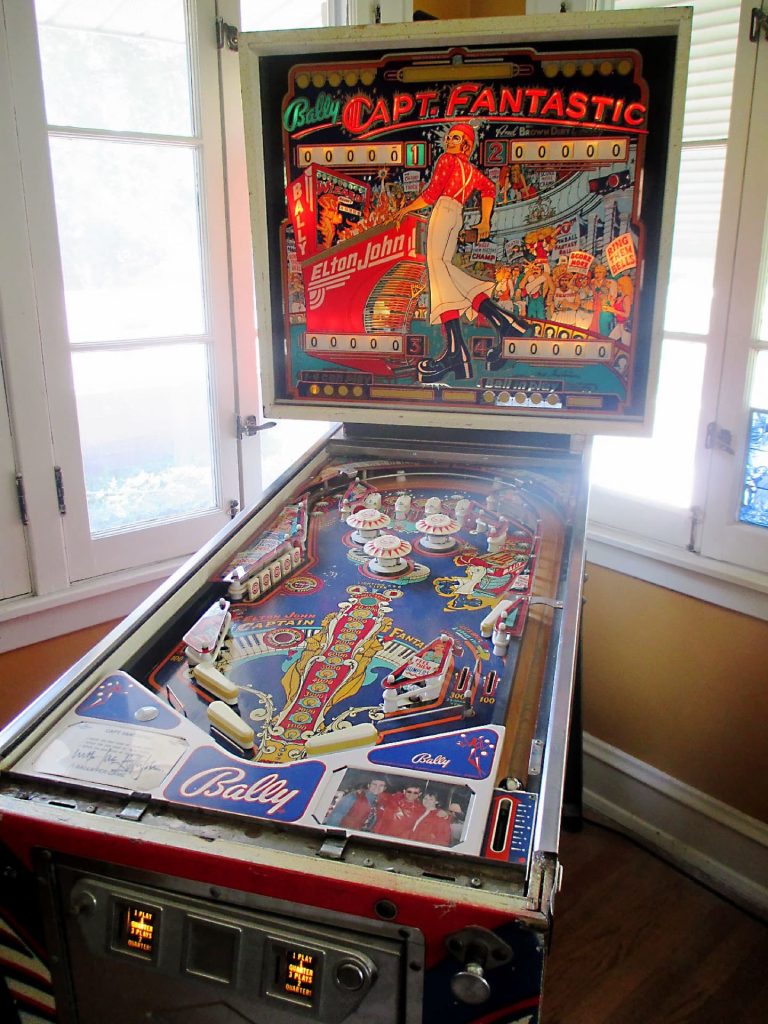
Bally’s 1976 “Captain Fantastic” pinball machine. (Photos: James Turano)
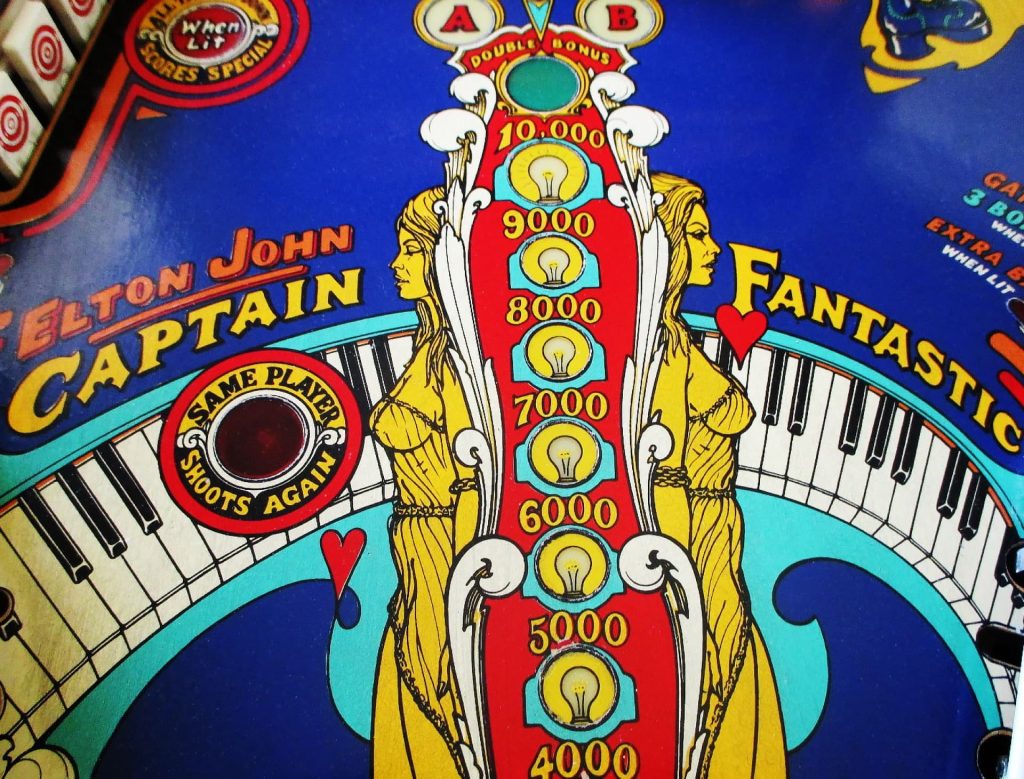
Nieman coordinated the multi-city promotional tour of Wizard!, in conjunction with Tommy’s schedule. As part of this, he attended the film’s world premiere party at the 57th Street subway station in New York City in March 1975 – the same event where David Frost did a television interview with Elton about his role in the film and his upcoming album Captain Fantastic And The Brown Dirt Cowboy.
The experience for Nieman was, “Like nirvana for a kid my age. But quite honestly, I viewed it as a one-and-done. I went back to my desk and started selling used equipment again. Until my boss came up to me one day and asked, ‘What’s your next game?’ I looked at him like he was speaking Latin.”
Undaunted, Nieman wrote down some ideas: “Names of celebrities. Basically, just people I wanted to meet. I created my List of E’s: Elvis, Elton, and Evel [Knievel]. And I got two of the three.” Nieman and Presley’s manager Colonel Parker could not come to an agreement.
“I saw Tommy I don’t know how many times and I thought Elton stole the movie. There was no question: the scene, the pinball, the boots…the whole thing.” With this in mind, Nieman reached out to Elton’s management and was asked to come to Los Angeles to expand his pitch for an Elton-themed machine. “I now knew how to get an airplane ticket,” he chuckles. “So I could go anywhere!”
Because of the Wizard! project, Nieman already had all of the relevant imagery for the Pinball Wizard character, as played by Elton in the film. “And that’s what I wanted to do,” he explains. “Elton John from the movie. But management said to me, ‘We want to call it Captain Fantastic And The Brown Dirt Cowboy, the name of his new album. It really is a co-mingling of brands: it’s visually one thing and name-wise it’s another. I was always shocked that no one pointed that out. Or the fact that the font style of ‘Captain Fantastic’ is unrelated to the album art, whereas ‘and the Brown Dirt Cowboy’ is lifted off it.”
Bally artist Dave Christensen used the Tommy movie stills and artwork collected by Nieman as a basis for his design. Sketches were approved by Elton’s management and the item went into production in early 1976. In March of that year, while Elton was in Toronto recording Blue Moves, Nieman visited him at his hotel for a collateral material photo session. “It was kind of a rare event for Elton to be staying in one place [for any length of time],” he points out. “So I said, ‘What if I send a prototype and we found someplace in the hotel to position it and hire a local photographer and we go up and shoot it?’ They said, ‘Just put it in his suite – it’s big enough and he’ll love it.’ And that’s exactly what we did.”
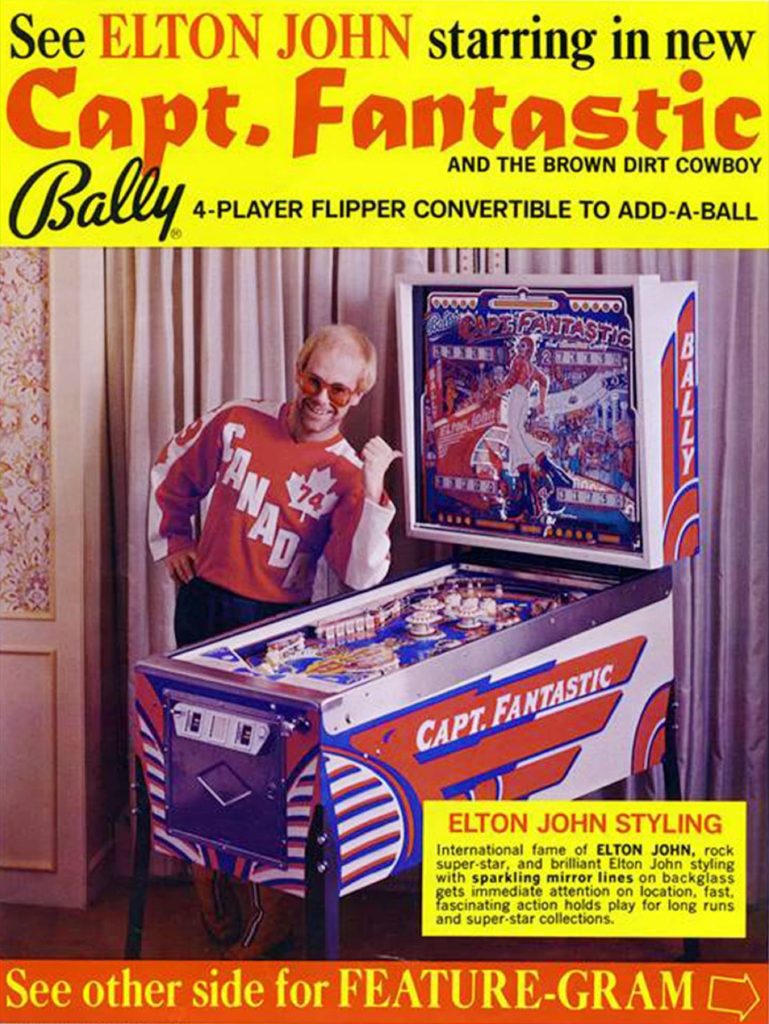
“At the hotel, there were a lot of young people waiting to get glimpses [of Elton getting] in and out of the limo or whatever, so there was high security. I had to go to a desk and ask for some strange name and then I went up to his suite. I made sure the machine was working and looked good and at some point, Elton came into the room wearing a Team Canada hockey jersey.”
“We sat and chatted,” Nieman recalls. “He could not have been a more quiet, unassuming, un-celebrity-like person. Given the stage persona, I don’t know what I was expecting. I guess that he was always ‘on.’ But he could not have been nicer. He said how excited he was and he loved the look of it. I’ve met some celebrities when we did artwork for them and they are a big pain in the ass. He couldn’t have been nicer about everything. We fired the machine up and played a couple of balls while the photographer worked out the lighting. It was a little event…it wasn’t like this big photo shoot.”
“That summer he went on tour,” Nieman continues. “Part of our deal was to give away maybe 20 machines; I ran around to a number of his concerts. I did New York, Chicago, Philadelphia… They were very nice to me and I got to go backstage and stand off to the side of the stage or go to the front row if I wanted. It was the time of my life.”
The Captain Fantastic machine sold roughly 16,000 units. To put that number in context, the previous few years’ sales at Bally (Wizard! aside) netted roughly 3,000 units per machine. Their largest competitor at the time, Gottlieb, might have done 7 or 8,000 at best. “When I did Wizard!,” Nieman says, “we blew through 5,000 and everyone couldn’t believe it. Actually, we ended up cutting it short because we didn’t order enough parts! We could have gone on, but they literally didn’t have enough glass or playfield or whatever. So in essence we left the public hungry, which is not a bad thing to do. So the hard-core pinball people were anticipatory of what’s next. And Captain Fantastic was the next big promotion. Everybody wanted to get on board. It got a lot of publicity, some from consumer but mostly trade. And…I got to order enough parts.”
“We actually had to stop production of Captain Fantastic at one point and go into [producing another machine] and come back to it because they had to put another order in for playfields – those were the most difficult thing to manufacture. So the total on the run was just over 16,000, which at the time made it the biggest game in the history of the industry.”
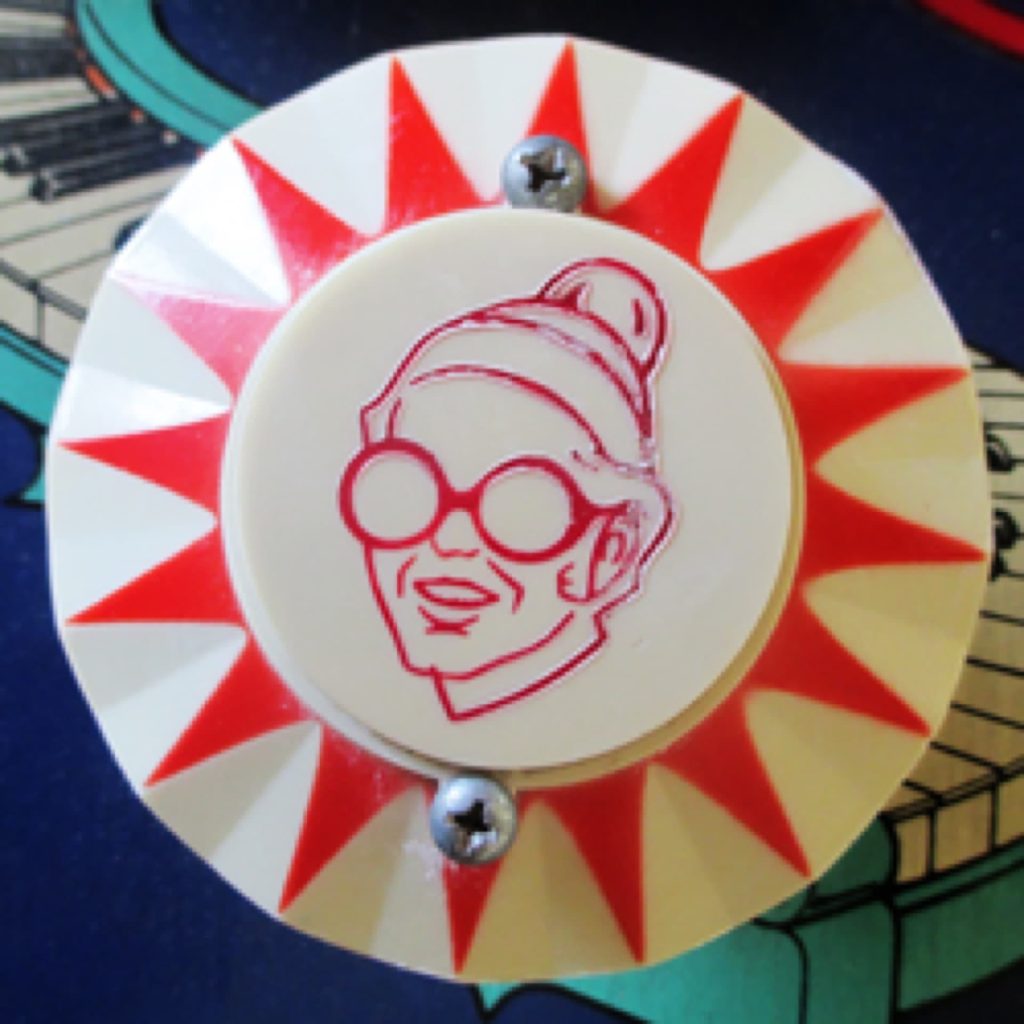
A bumper. (Photo: James Turano)
And took Bally from third place in the industry to first. “The attention of Wizard! got it started and then Captain Fantastic solidified our status,” concluded Nieman. “Every kid knew about it and wanted to go to the arcade and play it.”
So much so that the following year, fans could enjoy a second Elton pinball machine, also called Captain Fantastic And The Brown Dirt Cowboy, this time using Alan Aldridge’s original artwork from a never-realised animated film based on his 1975 album cover design.
